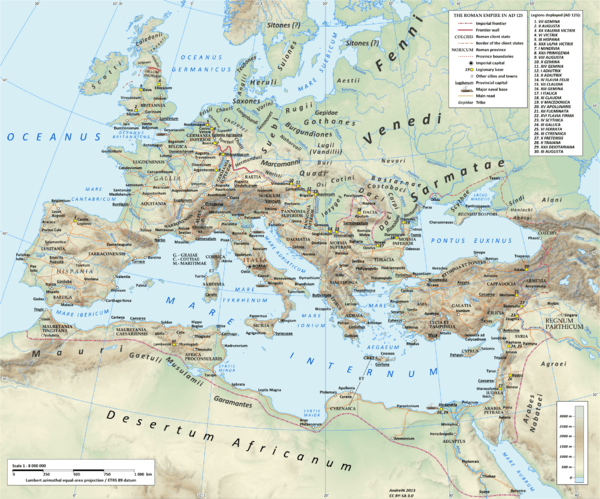Thuringii

The Thuringii or Toringi were a Germanic tribe which appeared late during the Völkerwanderung in the Harz Mountains of central Germania around 280, in a region which still bears their name to this day — Thuringia. They evidently filled a void left when the previous inhabitants — the Alamanni — migrated south to the region named after them, Alemannia. They may have been remnants of the Alemannic confederation, or simply another lesser tribe. Some have suggested that they were the remnants of the Hermanduri, that last part of whose name (-duri) was corrupted (-thuri) and afterwards suffixed with -ing, meaning "descendants of (the [Herman]duri)".[1] Claudius Ptolemy mentions neither tribe in his geography but instead the Teuriochaemae, who may also be connected to later Thuringians.
Political history

The Thuringii established an empire in the late 5th century. It reached its territorial peak in the first half of the 6th before it was conquered by the Franks in 531–532. Examination of Thuringian gravesites reveal cranial features which suggest the strong presence of Hunnic women or slaves, perhaps indicating that many Thuringians took Hunnic wives or Hunnic slaves following the collapse of the Hunnic Empire.[2] There is also evidence from jewellery found in graves that the Thuringians sought marriages with Ostrogothic and Lombard women. The Lombard king Agilulf (590–616) was of Thuringian descent.
After their conquest, the Thuringii were placed under Frankish duces (dukes), but they rebelled and established themselves independently again by the late 7th century under Radulf. Towards the end of this century, parts of Thuringia came under Saxon rule.
By the time of Charles Martel and Saint Boniface, they were again subject to the Franks and ruled by Frankish dukes with their seat at Würzburg in the south. Under Martel, the Thuringian dukes' authority was extended over a part of Austrasia and the Bavarian plateau. The valleys of the Lahn, Main, and Neckar rivers were included. The Raab formed the south-eastern border of Thuringia at the time. The Werra and Fulda valleys were within it also and it reached as far as the Saxon plain in the north. Its central location in Germania beyond the Rhine was the reason it became the point d'appui of Boniface's mission work.
The Thuringii had a separate identity as late as 785–786, when one of their leading men, Hardrad, led an abortive insurrection against Charlemagne. The Carolingians codified the Thuringian legal customs (but perhaps did not use them extensively) as the Lex Thuringorum and continued to exact a tribute of pigs, presumably a Merovingian imposition, from the province. In the 10th century, under the Ottonians, the centre of Thuringian power lay in the north-east, near Erfurt. As late as the end of the 10th century, the porcine tribute was still being accepted by the King of Germany.
Ecclesiastic history
The Thuringii had been converted to Christianity in the 5th century, but their exposure to it was limited. Their real Christianisation took place, alongside the ecclesiastical organisation of their territory, during the early and mid 8th century under Boniface, who felled their "sacred oak" at Geismar in 724, abolishing the vestiges of their paganism.
In the 1020s, Aribo, Archbishop of Mainz, began the minting of money at Erfurt, the oldest market town in Thuringia with a history going back to the Merovingian period. The economy, especially trade (such as with the Slavs), greatly increased after that.
Social history
The Thuringian nobility, which had an admixture of Frankish, Thuringian, and Saxon blood, was not as landed as that of Francia. There was also a larger population of free peasant farmers than in Francia, though there was still a large number of serfs. The obligations of serfs there were also generally less oppressive. There were also fewer clergymen before Boniface came. There was as small number of artisans and merchants, mostly trading with the Slavs to the east. The town of Erfurt was the easternmost trading post in Frankish territory at the time.
Historiography
The history of the Thuringii is best known from the writings of their conquerors, the Franks. Gregory of Tours, a Gallo-Roman, includes the nearest account in time of the fall of the Thuringian Empire. Widukind of Corvey, writing in 10th-century Saxony, inundates his similar account with various legends.
The Thuringii make brief appearances in contemporary Italian sources when their activities affect the land south of the Alps. Procopius, the Byzantine author, mentions them and speaks of their fall. The 7th-century Origo Gentis Langobardorum mentions a king of the Thuringii, Fisud, as a contemporary of Theudebert I.
Sources
- Reuter, Timothy. Germany in the Early Middle Ages 800–1056. New York: Longman, 1991.
- Thompson, James Westfall. Feudal Germany. 2 vol. New York: Frederick Ungar Publishing Co., 1928.
- Schutz, Herbert. The Germanic Realms in Pre-Carolingian Central Europe, 400–750. American University Studies, Series IX: History, Vol. 196. New York: Peter Lang, 2000.
See also
- List of Germanic peoples
- Barbarian invasions
- Turcilingi
| ||||||||||||||||||||||||||||||||||||||||||